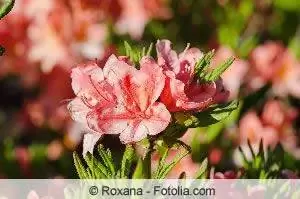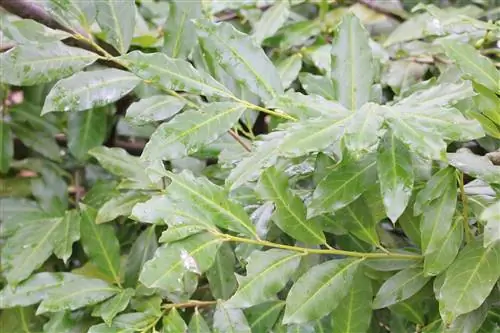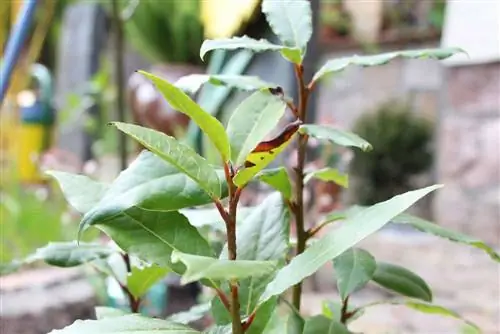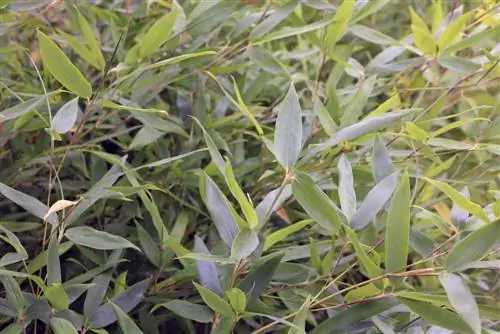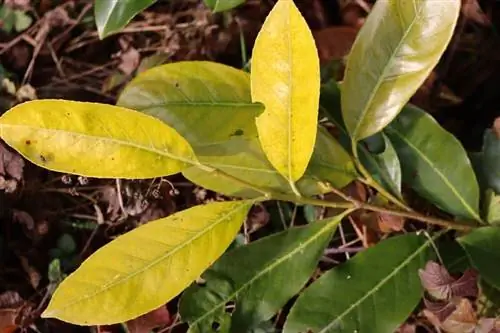- Author admin [email protected].
- Public 2023-12-17 03:39.
- Last modified 2025-01-24 12:45.
The rhododendron is loved by many hobby gardeners. Some gardeners have a passion for collecting because of the many beautiful flower colors of rhododendrons. But some have little luck with the evergreen flowering trees. The leaves often turn yellow, brown or mottled or the buds of rhododendrons turn brown. Sometimes entire shoots wilt. Such problems can have complex causes, which can be found either in an incorrect location, incorrect care or an infestation with harmful insects.
Yellow leaves with dark veins (chlorosis)
The most common appearance on rhododendrons is yellow leaves. If yellow leaves with green veins appear on your rhododendron and it hardly produces any flower buds, then this is a sign of iron and magnesium deficiency. Possible causes for this are soil that is too calcareous or irrigation water that is too calcareous. If your rhododendron bushes are too close to fresh foundations, lime leaching from the fresh mortar or concrete can also be a cause of chlorosis. Because then the entire soil becomes too alkaline. However, rhododendrons require acidic soil with a pH of 4.5 to 6.0.
Measures
You can help with a special rhododendron fertilizer that mainly contains iron and magnesium. The fertilizer also contains all the other nutrients such as phosphate, nitrogen, potassium and sulfur that rhododendrons need to stay he althy and produce lots of flower buds. It is also important to improve the soil, for example with rhododendron soil. Measure the soil pH regularly. If it is too alkaline, it is advisable to lower the pH using elemental sulfur. To do this, you can spread a tablespoon of sulfur powder in the crown eaves area of plants with severe chlorosis. If you live in a region where the surface water has a high pH value, long-term rhododendron cultivation is only possible in raised beds that are completely filled with special rhododendron soil.
Tip:
Never use aluminum sulfate to acidify the soil! Aluminum ions have a toxic effect on plants!
Young leaves brown and deformed
Brown and deformed young leaves are usually signs of frost damage and can especially occur in less winter-hardy rhododendron species. If the leaves are brown or lightened in summer, then it is usually sunburn. Leaves and shoots can also show burns in winter, for example from the winter morning sun.
Measures
You have to pay attention to the right location when planting rhododendrons. It should be protected from the wind and not too sunny. Frost-sensitive rhododendron species should be protected in extreme locations in winter, for example with a mulch layer of pine needles and oak leaves on their shallow roots. However, the mulch should not involve the trunk too much. The leaves are protected with shade fabric or conifer branches.
Discolored, falling leaves in autumn
Some rhododendron plants develop yellow to reddish leaves in autumn, which later fall off. This is usually a completely natural process, because rhododendrons also shed their oldest leaves every two to three years.
Yellow leaves and stunted growth
If the leaves turn yellow and the rhododendron suffers, then it is a nitrogen deficiency. Rhododendron-Catawbiense hybrids, which require a lot of nitrogen, are particularly affected. They are so-called nitrogen consumers.
Measures
Horn shavings are very suitable as a nitrogen fertilizer for rhododendrons and are preferably incorporated into the soil in spring as a long-term fertilizer. If you like, you can of course also work with artificial fertilizer. But then only in March and again in May. If fertilization is carried out later, the shoots no longer have a chance to mature properly and become woody. Because only mature wood is frost-resistant.
Dried shoots
Dried shoots often indicate rhododendron wilt, which is caused by the fungus Phytophthora cactorum. The fungus clogs the ducts. If the infestation is very severe, the plants can even die completely.
Measures
- cut out affected shoots
- remove cut shoots from the garden
- Injections with 1% copper-lime broth
- apply every 10 to 14 days
- possibly choose a better location
Yellowish white speckled upper leaf surface
If the upper side of the rhododendron leaves is speckled yellow-green to yellowish-white, the underside of the leaf is noticeably black-brownish dirty and some leaves curl up, later dry out and fall off, then the plant is infected with the rhododendron bug (Stephanitis rhododendri). affected. The dark coating on the underside of the leaves is the droppings of the bugs and their larvae, remains of the moult and the larvae themselves. The rhododendron variety Flava is particularly susceptible to this bug. Rhododendrons in locations that are too dry and too sunny are also often affected.
Measures
In the months of May, June and July it is important to preventively check the undersides of the rhododendron leaves for infestation. If necessary, spray with an insecticide containing neem.
Rolled up leaves
When there is a severe lack of water, the leaves of the rhododendron curl up to protect against evaporation. These symptoms can occur in both summer and winter, depending on the weather.
Measures
- Apply a layer of mulch so that the water does not evaporate so quickly
- water regularly
- pay attention to soil moisture even in winter
- better location selection
- transplant if necessary
Brown spots on leaves
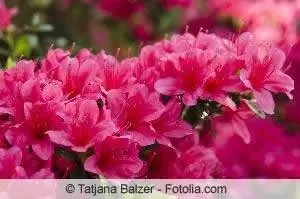
Rhododendrons in unfavorable locations often show round, brown spots on the leaves, which indicate fungal infection. Then you may be standing too close together with shallow-rooted large trees, which rob them of nutrients and thus weaken them.
Measures
The parts of the plants affected by fungi must be cut off and burned or thrown into household waste. They must not end up in the compost or organic waste. If the rhododendrons are too close together with shallow roots, they should be transplanted. Rhododendrons, for example, fit well under arborvitae, pines and false cypresses because these trees have long roots.
Withered, brown buds
Withered, brown buds with small black spines indicate rhododendron bud rot (Pycnostysanus azaleae), spread by the rhododendron leafhopper. In autumn, rhododendron leafhoppers lay their eggs in fresh buds. The yellowish larvae hatch in May of the next year and feed on the plant sap by sucking on the undersides of the leaves. A very severe infestation of rhododendron leafhoppers is noticeable in the mottled leaves. From around July onwards, the adults can be seen, jumping or flying away very quickly as soon as they are disturbed. This species of cicada is very easy to recognize due to its two slanting orange lines on its green forewings. Fungal infestation occurs even during egg laying. Because then the cicadas cut slits in the bud scales for the eggs. These injuries allow fungal spores attached to the leafhoppers to penetrate the plant. The damage will only become visible next spring.
Measures
As early as April, you should remove suspicious buds on a large scale and burn them or dispose of them with household waste. As a preventive measure, you can put up yellow signs in the summer. However, beneficial insects can also stick to it, such as bees, dragonflies, butterflies and bumblebees. Biological insecticides made from neem extract are also advisable to control the cicada population.
Tip:
Since there is unfortunately no effective fungicide to completely eradicate the fungus, you should rely on natural measures, such as regularly breaking out the affected buds, introducing natural predators such as songbirds and beneficial insects in the garden and treating rhododendrons regularly with homeopathic remedies strengthen.
Copper Leaves
This discoloration is a natural autumn and winter color of the rhododendron variety 'Winterpurpur'. In the cold season its leaves turn a beautiful copper color.
Felty covering
There are rhododendron varieties that have a felty coating (indumentum) on their leaves, for example Yakushimanum selections such as 'Schneekissen', 'Edelweiss', 'Koichiro Wada' or 'Silver Lady'. According to experts, due to the fine hairiness of the leaves, these varieties are not attacked by bugs and cicadas.
Conclusion
Rhododendrons need acidic soil and regular fertilization so that they thrive he althily and are immune to fungi and other diseases. Only with a good immune system can they defend themselves against harmful insects, fungal diseases and other adversities. The right location and a good water supply are also crucial to ensure that the plants remain he althy and strong. However, regular checks of the leaves and buds of rhododendrons are always advisable in order to prevent possible damage at an early stage or to stop it from spreading.

